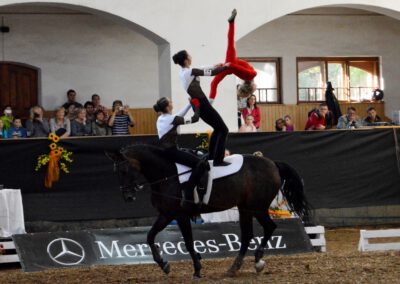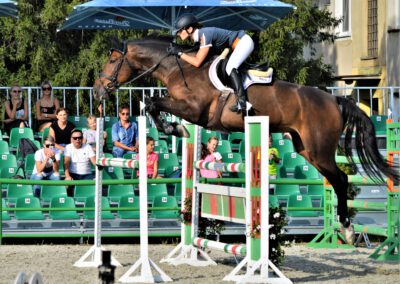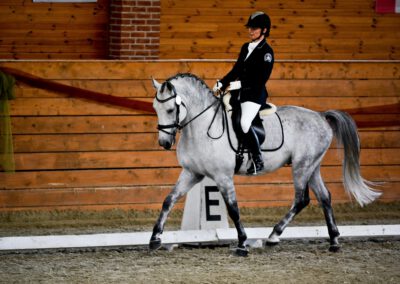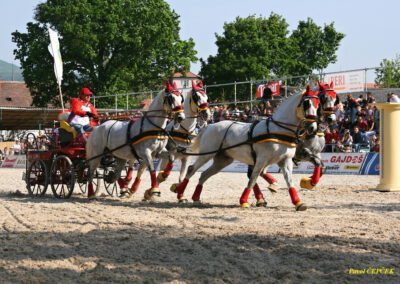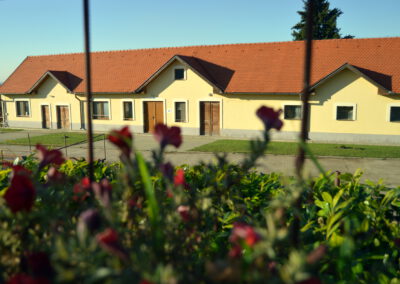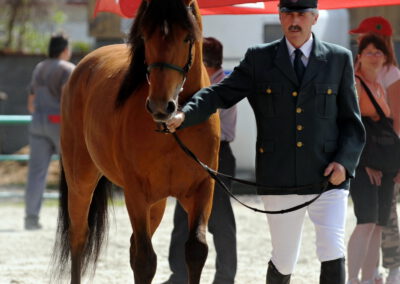Topoľčianky State Stud
Slovakia
HISTORY OF THE NATIONAL STUD FARM TOPOLCIANKY
National Stud Farm Topoľčianky, a state-owned company, is one of the most important breeding and crossbreeding centres for warm-blood horses in Europe. The Stud Farm was founded in 1921. It is unique because it is the only centre in the whole of Europe which specializes in four-horses breeding, which are Arabs, Lipizzaners, Hucul horses and sport horses. There are 550 horses in the herd. One part of the National Stud Farm is located in the grounds of the Famous Topoľčianky Castle which was a summer residence of Tomas G.Masaryk, the first President of the Czechoslovak Republic. There is an area of about 1000 ha with breeding yards and buildings, which were gradually added in the years 1921-1930.
The National Stud Farm Topoľčianky is well known also abroad mostly by its presentation of Lipizzaner horses with Quadrilla and Classical Riding School. Horses from Topoľčianky are very successful in all equestrian disciplines such as dressage, show jumping, endurance, driving and vaulting.
Topoľčianky State Stud
Parková 13
951 93 Topoľčianky
Slovakia
Riding hall
The Riding Hall is the dominant of the National Stud Farm Topoľčianky. It was built in 1910 and after its establishment, the stud farm took over the formerly Habsburg properties of the riding school building, which was the centre for horse breeding. Gradually other buildings for breeding were added. The riding hall was completely reconstructed for the occasion of the 80th anniversary of the establishment. Nowadays there is a main training centre for young horses and also a sport stable. The Riding Hall is visited by 30 000 tourists from Slovakia and abroad each year. After the reconstruction it became a place of state representation. Every year many diplomats, ministers, government officials and many important people from cultural, social and political life.
Outdoor arena
National Stud Farm Topoľčianky, every year organizes many National and International sport events (show jumping, dressage, breeding fairs, seminars and presentations). All these events take place in the historical Riding Hall and at the Outdoor arena which fulfils the strict quality criteria to organize events on a high level. On the 1st May, it is traditional Open Day, the largest event with a visit rate of more than 10.000 spectators.
Racecourse
It was in 1977 that the headstone was placed in order to build a new racecourse. The whole process took 4 years to be finalized and on the 29th August 1981, the racecourse was joyfully opened. It was the same day that the National Stud Farm celebrated its 60th foundation anniversary. During its history, many riding, training and breeding celebrities and professionals as well as great horses met in the area of Topoľčianky hippodrome.
In the late years, the racecourse is being used also as a centre of driving sport, breeding exhibitions and championships. The driving obstacles suitably match the colours of the tribunes, arbitral tower and the whole area. Thousands of visitors were able to experience the turf thrill and exciting atmosphere of the races surrounded by the scenic Tribeč Mountain. The National Stud Farm does everything to prepare turf meetings with all the necessary facilities for the professionals as well as the visitors. The racecourse records and time records made intro-Slovakia and Czechoslovakia are proof that the racecourse is of a high quality indeed. Topoľčianky horse-races are held four times a year.
Breeding facilities
Breeding facility Hostie is a complex of historical buildings. In the Hostie facility both Lipizzaner and Hucul herds are kept for breeding activities. Here are stables for breeding stallions and Lipizzaner broodmares with their foals. Parts of the facility are large fields and pastures.
Kosiar is a smaller breeding farm consisting of a cosy complex of buildings suitably situated opposite the Inovec Mountain with views of the Hostie sandy mine. Its main purpose is to take care of young Hucul horses – Hucul mares. There are some Hucul breeding stallions as well. The large pastures and tiny yards create a paradise for the hard Carpathian breed Hucul.
The highest placed stud farm is Rybnik. It situated 450 metres above sea level. Brick stables are typical for this farm. They are built to create a large park in the middle. There are open stables for keeping the young Arabian mares and the Slovak warm-blood mares as well as for the stud herd of valuable Shagya-Arabian mares together with Arab mares and a stable of the breeding stallions.
Breziny stud farm is situated near Žikava village and its main purpose is to breed all types of stallions, which are bred in Topoľčianky National Stud farm. Interconnected free open stables figured like the letter H are typical for this place as well as the large renewed pastures. There are also some training stables. Topoľčianky National Stud Farm management decided to establish a training centre for driving sport in Breziny stud farm in 2004. The training centre prepares the driving horses for sports and commercial purposes of the establishment.
Breeding facility Krasny Majer- Insemination and Reproduction Centre is used for breeding sport horses of Slovak Warm blood. A part of Krasny Majer also is IRC – Insemination and Reproduction Centre. It was established by using modern biotechnology in horse breeding to answer the purpose of not only the National Stud Farm but also the other horse breeders in Slovakia. Part of IRC, registered under the European number ISZ – 01 SK, is also a sperm bank, in which are more than 3000 doses of the rare stallion’s sperm.
Hippological exposition
The tradition of horse breeding in Slovakia is rich in all life areas. In the 1980’s, the National Stud Farm in Topoľčianky has made a decision to develop the museum of horses, which are beneficial for preservation of this inheritance for following generations. After the building reconstruction according to a well-prepared project the collecting of hippological artefacts began. A new carriage shelter for vehicles pulled by horses was built. The exposition provides compact conception of horses and their utilization in society.
